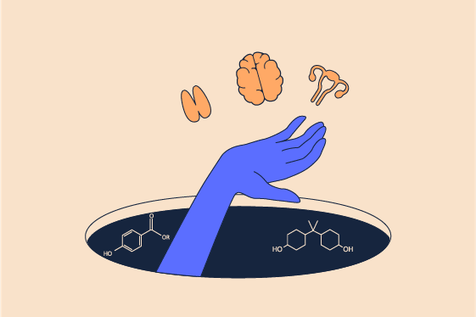How to better track my ovulation
Being able to pinpoint your time of ovulation is key to understanding your fertile window. But did you know the hormones we produce as a result of ovulation also have essential roles for our general health and wellbeing? Because of this tracking your ovulation can benefit more than just your fertility.
What is ovulation?
Ovulation is the release of an egg from the ovary into the Fallopian tube. It usually occurs around 13 - 15 days before the start of each period (1).
Eggs grow in structures called follicles. At the beginning of every menstrual cycle there are around ten follicles that are possible candidates for ovulation (2). During the first half of the cycle the brain produces follicle stimulating hormone (FSH) which - as the name suggests - stimulates follicles to grow. As follicles develop they start to produce increasing amounts of the hormone estrogen. From the group of growing follicles one dominant follicle is eventually selected for further growth. Estrogen levels continue to rise, finally reaching a threshold level that causes the brain to produce a surge of luteinising hormone (LH) which triggers ovulation (3). LH causes an increase in enzymes that weaken the wall of the ovary near to the follicle allowing the egg to pass through into the Fallopian tube (4). The release of the egg happens approximately 24 - 36 hours after the onset of the LH surge (5, 6). After ovulation, the corpus luteum, which is the structure left over after ovulation, begins to produce progesterone (7). This only happens if ovulation has taken place. Progesterone prepares the endometrium for implantation of the fertilised egg. If no fertilisation takes the place, the corpus luteum breaks down and hormone levels drop, causing menstruation to begin.
Why should I track my ovulation?
Problems with ovulation are the main cause of female infertility (8). Without ovulation, there is no egg released for fertilisation and pregnancy cannot occur. A menstrual cycle with no ovulation is called an anovulatory cycle. Anovulatory cycles are quite common and most people will experience them at some point during their fertile years. However they are most likely to occur in the first few years after menarche (the first menstrual period) and in the years leading up to menopause. In addition to affecting fertility, regular anovulatory cycles can also impact bone density, cardiovascular health and sleep. This is because hormones, such as estrogen and progesterone, that are produced as a result of ovulation have many roles beyond reproductive health. As a result, tracking your ovulation can benefit more than just your fertility. When tracking your ovulation you should remember that certain types of birth control work by preventing ovulation. These include methods that make use of both estrogen and progesterone such as the combined oral contraceptive pill (9).
How can I predict my ovulation?
Tracking your ovulation can help you predict or confirm ovulation. If you want an estimate of your fertile window in order to plan or prevent pregnancy there are a number of signs you can look out for.
Some people experience ovulation pain, also known as mittelschmerz. It can be a sharp or cramp-like pain that occurs on either side of the lower abdomen and can last a few hours or days. Ovulation pain does not happen at the time of ovulation itself but instead coincides with the peak of LH (10). Although the exact cause is still unknown, it is thought to be a result of ovarian muscle contractions that occur around the growing follicle (11). For some people ovulation can also be accompanied by spotting or ovulation bleeding, although this is less common (12).
Measuring LH levels can be a way to catch the onset of the LH surge that occurs prior to ovulation. This can be done using an over-the-counter home ovulation test. If you want to make the most of your fertile window, this approach may not be the best method for you. The fertile window can begin up to five days before ovulation - see our article Can I get pregnant any day of my cycle? - while LH tests usually only give you around 24 hours advanced warning (13).
Research has also shown that the pattern of LH surge can vary widely between individuals – some may experience a single short peak of LH lasting less than five days, while others may have a longer increase of LH which plateaus and extends beyond ovulation (14). In such cases an LH test taken after ovulation will miss the fertile window despite being positive. Another point to remember is a rise in LH does not always mean ovulation; LH levels can also increase in anovulatory cycles (15).
Changes in cervical fluid can be used to track the fertile days approaching your ovulation and give you a bigger fertile window to take advantage of. As estrogen levels peak, 1–2 days before ovulation, cervical fluid takes on a raw egg white consistency making it easier for sperm to swim through (16). While changes in cervical fluid can be helpful to indicate the days during which you are most fertile like measuring LH it cannot confirm that ovulation has taken place. This is why it’s important to have a way of both predicting and confirming ovulation which is exactly what you can do with inne!
Predicting & confirming your ovulation with inne
Confirming ovulation is all about tracking the increase in progesterone that occurs after ovulation. Through a saliva test the inne minilab monitors daily changes in your progesterone levels. By building a baseline during the first half of your cycle, the system can then detect the increase in progesterone during the second half confirming that ovulation has taken place. The inne minilab can also make an estimate of your fertile window, this is done based on a combination of your cycle history and your current cycle’s progesterone patterns. As the system collects your hormone data cycle by cycle, this prediction becomes more refined. Through regular use, inne creates a personal record of your cycle making it easy for you to pinpoint your ovulation exactly - or to recognise or identify any irregularities.
References
-
Lenton EA, Landgren BM, Sexton L. Normal variation in the length of the luteal phase of the menstrual cycle: identification of the short luteal phase (1984). Br J Obstet Gynaecol. 91, 685-9.
-
McGee EA, Hsueh AJ. Initial and cyclic recruitment of ovarian follicles (2000). Endocr Rev. 21, 200-14.
-
Baerwald AR, Adams GP, Pierson RA. Ovarian antral folliculogenesis during the human menstrual cycle: a review (2012). Hum Reprod Update. 18, 73-91.
-
Richards JS, Russell DL, Robker RL, Dajee M, Alliston TN. Molecular mechanisms of ovulation and luteinization (1998). Mol Cell Endocrinol. 145, 47-54.
-
Hoff JD, Quigley ME, Yen SS. Hormonal dynamics at midcycle: a reevaluation (1983). J Clin Endocrinol Metab. 57, 792–796.
-
World Health Organization Task Force Investigators (1980). Temporal relationships between ovulation and defined changes in the concentration of plasma estradiol-17beta, luteinizing hormone, follicle stimulating hormone, and progesterone. Am J Obstet Gynecol 138, 383–390.
-
Reed, B. G. & Carr, B. R. The normal menstrual cycle and the control of ovulation. In Endotext (eds. De Groot, L. J., Chrousos, G. & Dungan, K., 2015)
-
Walker MH & Tobler KJ. Female Infertility. In StatPearls (Updated 2020).
-
Rivera R, Yacobson I, Grimes D. The mechanism of action of hormonal contraceptives and intrauterine contraceptive devices (1999). Am J Obstet Gynecol. 181, 1263-1269.
-
O'Herlihy C, Robinson HP, de Crespigny LJ. Mittelschmerz is a preovulatory symptom (1980). Br Med J. 280, 986.
-
Brott NR, Le JK. Mittelschmerz. In StatPearls (Updated 2020).
-
Dasharathy SS, Mumford SL, Pollack AZ, Perkins NJ, Mattison DR, Wactawski-Wende J, Schisterman EF. Menstrual bleeding patterns among regularly menstruating women (2012). Am J Epidemiol. 175, 536-45.
-
Su HW, Yi YC, Wei TY, Chang TC, Cheng, CM. Detection of ovulation, a review of currently available methods (2017). Bioeng Transl Med. 2, 238 - 246.
-
Direito A, Bailly S, Mariani A, Ecochard R. Relationships between the luteinizing hormone surge and other characteristics of the menstrual cycle in normally ovulating women (2013). Fertil Steril. 99, 279-285.
-
Killick S, Elstein M. Pharmacologic production of luteinized unruptured follicles by prostaglandin synthetase inhibitors (1987). Fertil Steril. 47, 773–777.
-
Bigelow JL, Dunson DB, Stanford JB, Ecochard R, Gnoth C & Colombo B. Mucus observations in the fertile window: a better predictor of conception than timing of intercourse (2004). Hum Reprod. 19, 889-892.




